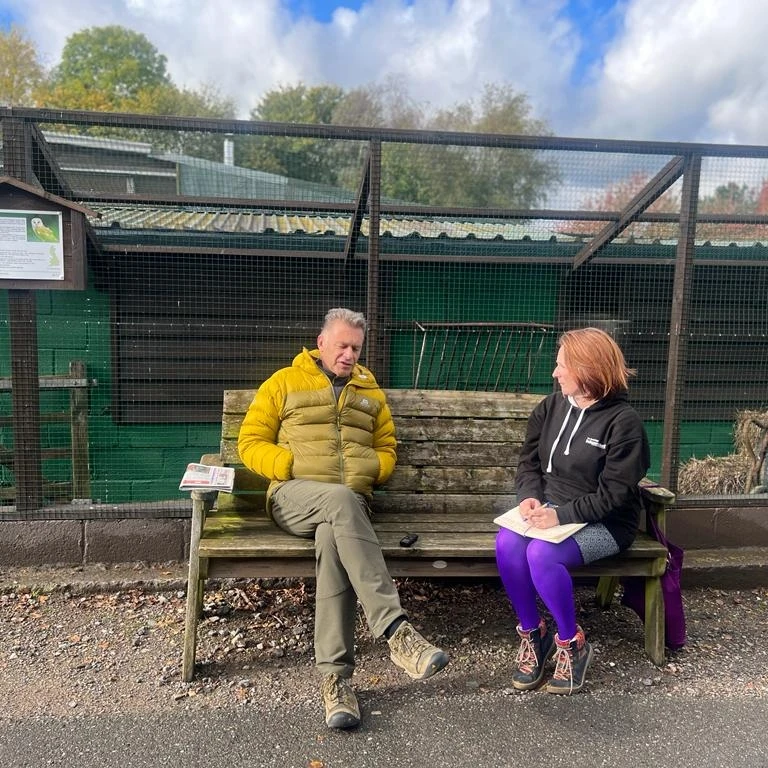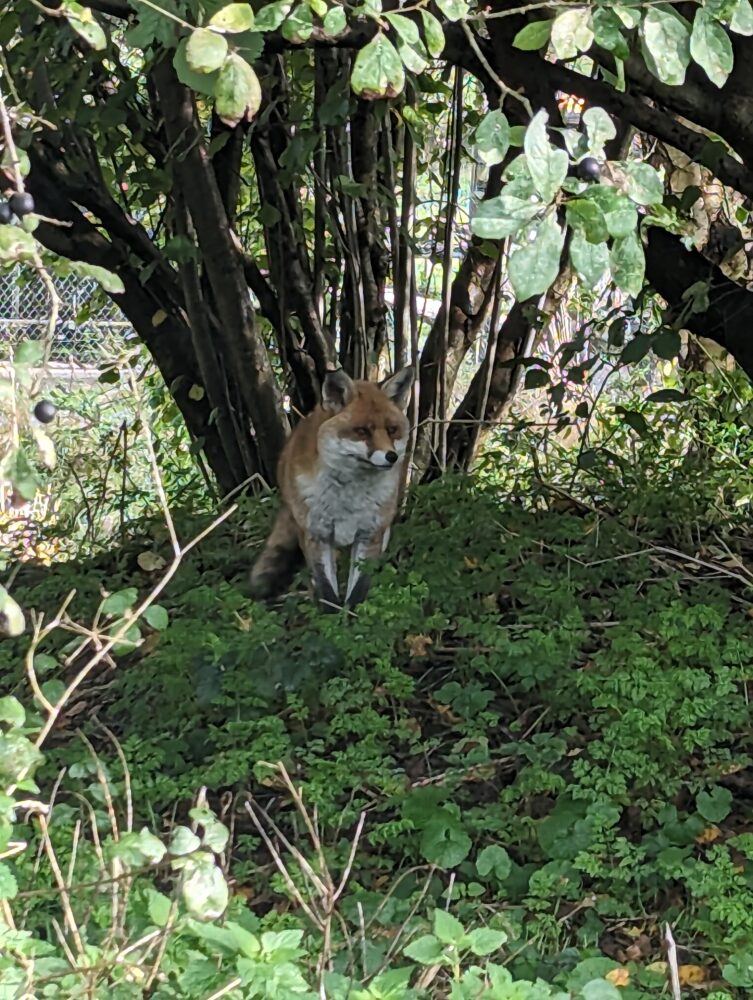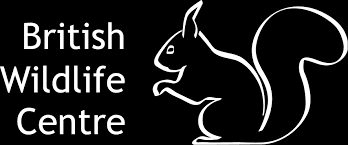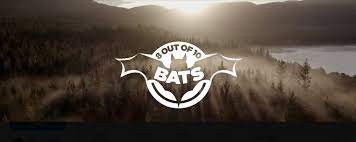Conservationist, television presenter, campaigner, writer and photographer Chris Packham has been filming his new YouTube wildlife programme 8 out of 10 Bats at the British Wildlife Centre in Lingfield this week.
We were given an exclusive interview with him, where we asked him about the show, how well he knows Surrey and why the centre is so important for wildlife. Here is what he told us.

When did you first come to the British Wildlife Centre?
We came here to film in around 1998 or 99 – for a series I was making for ITV – and we’ve been coming here ever since. I spend a lot of time here taking photographs on my own, and then we’ve come and filmed here quite a few times.
The animals are in really nice, naturalistic enclosures which are perfect for filming and photography, they’re a really great resource. And we’re really keen to support the conservation work they do. Initially they were breeding red squirrels as part of a project to establish captive breeding colonies in the UK. They are also one of the collections that holds the Scottish wildcat, they’re part of that important project.
The reason this is necessary is that wildcats had been functionally extinct, because they’re been so interbred with domestic cats. Various collections around the country have been sharing purebred wildcats to ensure there is less inbreeding and they are kept genetically strong, and this year a group of wildcats have been released in the Cairngorms.
The centre has some here. They’ve been breeding them and have kittens now, which we saw yesterday and are gorgeous. It’s great to think that one day kittens could be born here which could go back into the wild.
Why is the British Wildlife Centre so important?
There are a number of reasons why the centre is so important. We underestimate how good and beautiful our native wildlife is, that’s the first thing. We live in an age where we’re drawn to celebrity the whole time. It’s always about the big and the flash, the whales and the dolphins and the tigers. But the best wildlife for me is the wildlife I engage with in my community. It’s the things that I see regularly, hopefully in my garden or over the fence.

Every species here is available in the wild for people to go and see, if they want to. Some of the creatures might be trickier than others: although pine martins do occur in other parts of the UK now, their stronghold is in Scotland and they’re quite shy, but there are places where you can go and see them. I was stood at the pine martin enclosure for about 20 minutes yesterday because I haven’t seen them in the flesh for years!
It’s a great place for young people to see all types of British wildlife close up. The centre gets huge numbers of young people here on school visits, and at weekends families come too. And the key thing is that the animals are used to being looked at, they’re not hiding away. I’ve been here on occasion and not been able to see something because it’s been having a nap, but other than that you should be able to see all the species here.
So it’s great for engagement. Engagement then leads to education. The keepers do great interactive talks about the animals, lots of information is passed on.
The upshot of engagement and education is that hopefully people then care more about the species, and that’s where the conservation angle comes in. The centre can say ‘many of the species here are in trouble’ and explain why, like the wildcats or the red squirrels, because of a virus that is passed to them by grey squirrels, so we’ve seen a massive range contraction in the UK of those. There are quite a few species here whose wild counterparts have declined quite rapidly, and that conservation message in inherent in everything the centre does.
And the last thing is the centre has a really good feel to it: I like it. It’s not too big or too flashy, it’s almost like a family-run business. There’s a community of people that work here who are all very dedicated..
How well do you know Surrey?
Relatively well. The first thing I remember, from a natural history point of view is the Surrey heaths, because that is a very rare habitat. We had some in Hampshire and there are some in Dorset but that’s about it really. So Surrey heathland is really important. I remember coming to Thursley Common to look at dragonflies and natterjack toads which were being reintroduced. It’s also good for hobbies and reptiles on those heaths. So that I know quite well.
There was a wildlife hospital we used to go to as well, but sadly that’s closed down now. My ex-partner used to bring me shopping in Guildford, so I went there quite often, which perhaps I enjoyed slightly less! No disrespect to the people of Guildford, it was the shopping I didn’t like!
But the heaths are the core. It’s an internationally important habitat, so Surrey has internationally important areas of that sandy lowland heath. Some have been given over to the military, which is fine as the MoD do quite a good job looking after them, while the others have public access.
The BBC cancelled Autumnwatch this year: what made you decide to start up 8 out of 10 Bats in its place?
Megs (Megan McCubbin, Chris’ stepdaughter) and I did the Self-Isolating Bird Club (SIBC) during lockdown (an online bird-watching community), and we met Fabian, who’s now live directing 8 out of 10 Bats. He basically increased the technology and the quality of it. It started on our mobile phones and he helped us do it in a much more polished way. In the interim period, we bought more equipment, so we knew we had the capacity to do something that was a little bit more slick, more composed, more formulated.
I spend quite a lot of my time campaigning and essentially, when I’m campaigning, I’m asking for something from people. Firstly, I’m asking for their attention, I’m saying ‘You need to listen to this, it’s important.’ And then sometimes I ask them to do something, like sign a petition or turn up at a demonstration. And occasionally, I have to ask them for money, and they’re always very generous. But you can’t keep just asking, I think that you’ve also got to give something back. So Bats is free for people to watch on YouTube.
The other things is, I’ve got a real vocational interest in giving young people a chance to do things. So we came up with this plan that Bats would be all about young people. There are a few people on the crew who are about the same age as me, maybe a bit younger, but the vast majority of people working on this project, or featuring in it are young: they’re under 30. We had a goal of 25 per cent of our contributors being under 25, and we trounced that, we’re at 30 something per cent.
We also had a diversity goal of 25 per cent, and again, we trounced that, it’s over 30 per cent. Unfortunately, in the TV production world, and in the wildlife world, there are too many white blokes, quite frankly. We needed to break that down and make that more accessible to a far greater range of people.
So we set those sorts of parameters and then began bringing some young people together, and it’s about giving them an opportunity to show their skills, their abilities as filmmakers, photographers, campaigners, conservationists etc. It’s been great, we’ve had some really good films.
(Below: the 8 out of 10 Bats set at the British Wildlife Centre)



Where did you find the 8 out of 10 Bats presenters?
We found a lot through social media. That’s what I’d been doing: finding these great young conservationists, boosting their stuff, and occasionally corresponding with them. George (George Hassall) we knew through SIBC. He was doing gardening videos during lockdown, and Megs and I found him on social media and he then started doing bits for us.
Indy (Indy Kiemel Greene), we found on social media as well, and Lucy (Lucy Lapwing) we met during SIBC. It was a time when a lot of people were reaching out and I was always keen to get as many young people in there as possible. Christina (Christina Sinclair) approached me to help with a fundraising thing she was doing, which I did, and then I started promoting her blogs.
These are untested live presenters – George, for example, was very comfortable doing videos, but he had never done any live TV before. The BBC can’t chuck somebody like George in front of an audience of three million people because it could go wrong, but we can – we had confidence in them. And it didn’t go wrong! My hope is, we give them an opportunity to show that they can do it, it boosts their confidence and gives them experience, and maybe they’ll get some work elsewhere off the back of it.
What happens next for 8 out 10 Bats?
I’d like a bunch of young people to own it as a co-operative, and monetise it so they can pay themselves and take it forward. Maybe they could do other sorts of events as well, that would be great.
Otherwise it’s really hard for them. People don’t get opportunities until they can already do these things, and how can they learn to do it if they don’t get these opportunities? I was in the same boat as many of these kids, and it was actually more difficult when I was young because at least they have access to technology. We didn’t have mobile phones to film things on and cameras were ludicrously expensive, so it was much harder, but I was very fortunate. I met people who gave me a chance, so I want to do the same back.
And what’s next for you?
I’ve been working on my online t-shirt shop. I’ve done around 40 designs now but I simply haven’t had time to get it up and running. It’s just sat there now, and it’s annoying me, so that’s my plan for the beginning of November.
I’m also meeting up with my campaign project partner and she and I are going to be putting together a more strategic plan about what we’re going to be doing in terms of our own campaigns.
I’ve also got some sculpture to do. Charlotte, my partner, is determined for me to find some time in November and December to finish off couple of pieces of sculpture I’ve started.
(On the type of sculptures he creates) Ghastly ones! Brutalist sculptures made of metal. I’ve done quite a few made of steel and some smaller ones in bronze.
(On whether he would exhibit them) I generally just do these things for myself. I wrote a book a few years ago*, but then left it stuck on a hard drive for two years. I eventually showed it to somebody and they said ‘maybe you should publish it’ and so I did but it was originally just for me.
I do paint, but sculpture is something I’d always yearned to do. I find it a lot more difficult than painting: I really like it, but that doesn’t mean I can do it. I listen to a lot of music and I have a guitar, but I just make a terrible noise. I haven’t got the discipline or the ability to play brilliantly. A man has got to know his limitations and actually it can be useful to confront those sometimes!
Then, we’ve got Winterwatch on the BBC after Christmas, and I’m hoping to do something for Channel 4 in the spring next year. Then at the end of next year there’s talk of another BBC series.
Which nature books do you like to return to?
There’s one book that I’ve always enjoyed rereading, and that’s called A Sand County Almanac by Aldo Leopold, who was a forester in the US in the 1930s. He was years ahead of his time as a conservationist; if only we’d listened to what he said then, we’d have a much healthier world now. It’s a series of essays, and there’s one called Escudilla, the story of a grizzly bear. It’s one of the most beautifully written and composed pieces of prose. I can’t read it without crying! I remember once, we were stuck on a ship: it was bad weather and we couldn’t move and everybody was climbing the walls.
I had this idea that every evening before dinner I’d read a section of a book. I’d been doing ones that everybody knew, like Ring of Bright Water and My Family and Other Animals, and it had been going quite well. Then I decided that I’d read Escudilla. I couldn’t get through it without crying, and then I looked up and saw that everybody else was in tears too! It’s a very powerful piece of writing.
The whole book is very beautiful written throughout, so for me I think it’s the best nature writing.
____________________________________
The British Wildlife Centre is open to the public every weekend and bank holiday (except 24, 25 and 26 December) and during the school holidays. Please check its website for opening times and further details to plan your visit.
You can watch 8 out of 10 Bats here.
* Chris’ book, Fingers in the Sparkle Jar: A Memoir is available here.











